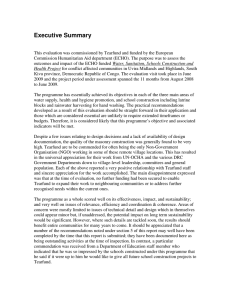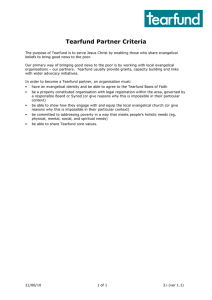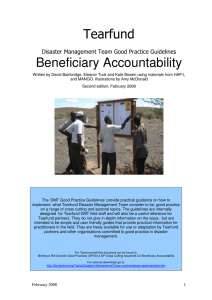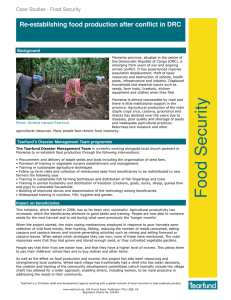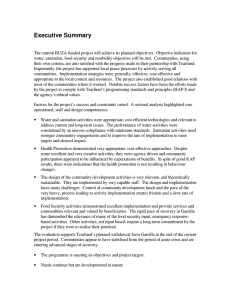Accountability to benefi ciaries in Kashmir Introduction
advertisement
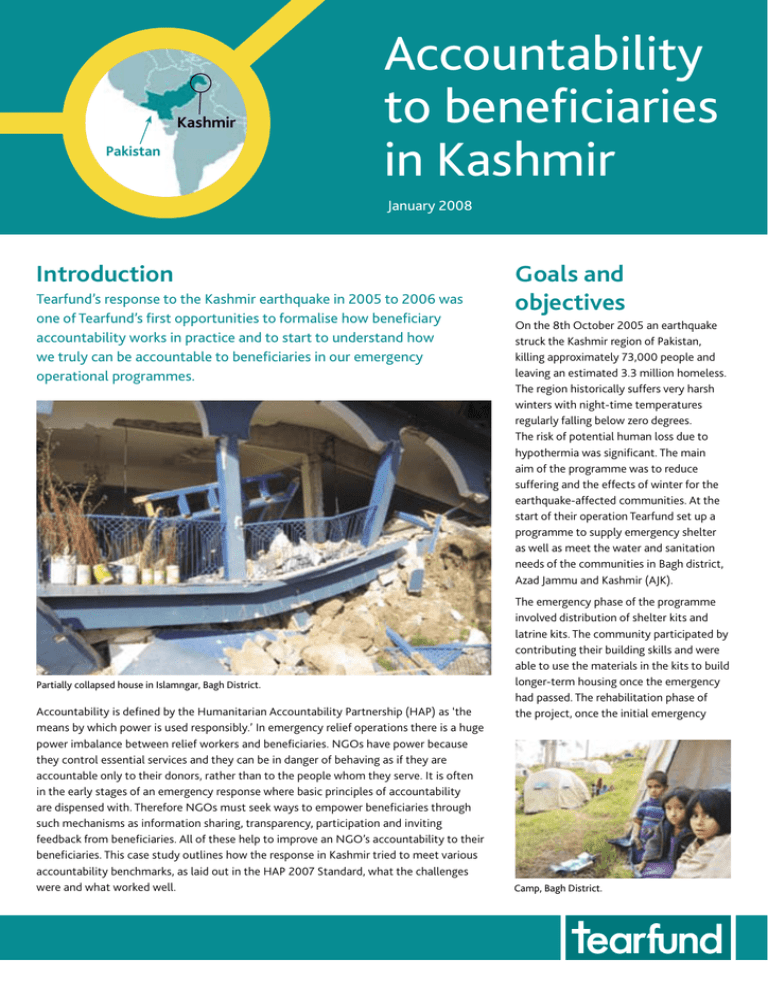
Kashmir Pakistan Accountability to beneficiaries in Kashmir January 2008 Introduction Tearfund’s response to the Kashmir earthquake in 2005 to 2006 was one of Tearfund’s first opportunities to formalise how beneficiary accountability works in practice and to start to understand how we truly can be accountable to beneficiaries in our emergency operational programmes. Partially collapsed house in Islamngar, Bagh District. Accountability is defined by the Humanitarian Accountability Partnership (HAP) as ‘the means by which power is used responsibly.’ In emergency relief operations there is a huge power imbalance between relief workers and beneficiaries. NGOs have power because they control essential services and they can be in danger of behaving as if they are accountable only to their donors, rather than to the people whom they serve. It is often in the early stages of an emergency response where basic principles of accountability are dispensed with. Therefore NGOs must seek ways to empower beneficiaries through such mechanisms as information sharing, transparency, participation and inviting feedback from beneficiaries. All of these help to improve an NGO’s accountability to their beneficiaries. This case study outlines how the response in Kashmir tried to meet various accountability benchmarks, as laid out in the HAP 2007 Standard, what the challenges were and what worked well. Goals and objectives On the 8th October 2005 an earthquake struck the Kashmir region of Pakistan, killing approximately 73,000 people and leaving an estimated 3.3 million homeless. The region historically suffers very harsh winters with night-time temperatures regularly falling below zero degrees. The risk of potential human loss due to hypothermia was significant. The main aim of the programme was to reduce suffering and the effects of winter for the earthquake-affected communities. At the start of their operation Tearfund set up a programme to supply emergency shelter as well as meet the water and sanitation needs of the communities in Bagh district, Azad Jammu and Kashmir (AJK). The emergency phase of the programme involved distribution of shelter kits and latrine kits. The community participated by contributing their building skills and were able to use the materials in the kits to build longer-term housing once the emergency had passed. The rehabilitation phase of the project, once the initial emergency Camp, Bagh District. Accountability to beneficiaries in Kashmir Benchmarks 1 The agency shall establish a humanitarian quality management system. 2 The agency shall make the following information publicly available to intended beneficiaries, disasteraffected communities, agency staff and other specified stakeholders: a organisational background; b humanitarian accountability framework; c humanitarian plan; d progress reports; and Michel Kok e complaints handling procedures. Temporary shelter built with kit distributed by Tearfund, Bagh District. of winter survival had passed, included rehabilitation of water supply, public health promotion and earthquake risk reduction, such as promotion of earthquake-proof building designs and community-based earthquake contingency planning. Tearfund was committed to emphasising its accountability to beneficiaries through both the emergency and reconstruction phases of the programme. HAP Standard in Humanitarian Accountability As a member of Humanitarian Accountability Partnership International (HAP International), Tearfund aims to comply with the HAP 2007 Standard in Humanitarian Accountability and Quality Management, which lays out a set of Tearfund was committed to emphasising its accountability to beneficiaries through the emergency and reconstruction phases of the programme 2 3 The agency shall enable beneficiaries and their representatives to participate in programme decisions and seek their informed consent. principles of accountability from which six benchmarks have been established for organisations to measure themselves against. These are shown in the box (right). 4 The agency shall determine the competencies, attitudes and development needs of staff required to implement its humanitarian quality management system. At the time of Tearfund’s response to the Pakistan earthquake, the team were working according to the HAP principles. These were only subsequently developed into the HAP benchmarks and this case study retrospectively analyses the lessons learned according to those benchmarks – particularly benchmarks 2, 3, 4 and 5 which are detailed below. 5 The agency shall establish and implement complaints handling procedures that are effective, accessible and safe for intended beneficiaries, disaster-affected communities, agency staff, humanitarian partners and other specified bodies. Tearfund’s approach As a means of ensuring beneficiary accountability among the projects, the programme employed two Accountability Assistants and an Accountability Officer from existing staff, within the first months of the operation. Based in the field office and head office respectively, their role was to collate information, write reports, manage the response to suggestions and complaints, and generally manage conflict resolution in the communities that were linked to the project. The Accountability Officers would gather information by being present at all distributions, they would talk to committees about their issues (water, 6 The agency shall establish a process of continual improvement for its humanitarian accountability framework and humanitarian quality management system. shelter, etc.) and empty suggestion boxes. They always accompanied project staff to gain access to the beneficiaries and only rarely worked independently of project staff. This enabled the Accountability Officers to take advantage of committee meetings to gain information as well as improve the understanding of the project staff on how to be more accountable to the beneficiaries. This also enabled staff and beneficiaries alike to see accountability to beneficiaries as an integral part of the project and not a separate activity. Accountability to beneficiaries in Kashmir was disseminating. This enabled the team to improve their methods. Sarah Dilloway All information was given in the local language in verbal communication and in Urdu for written communication. Tearfund notice board with from top left to bottom right: list of committee names, contact phone numbers, diagrams of water system, map of water system, list of standard operating procedures for the course of the project, information about Tearfund and its values, special notices such as not doing distributions during the election period. The budget for accountability activities including the salaries of specialist staff and printing costs, notice boards and suggestion boxes, came to approximately 2% of the total project budget. Benchmark 2 MAKING INFORMATION PUBLICLY AVAILABLE Information was made publicly available in a number of formats: on notice boards, on posters, through FM radio, through verbal communication from community leaders and through verbal communication by staff at distributions and public health meetings (sometimes using megaphones). Formats were chosen according to what was normal for the community as well as what was most effective for the type of information being disseminated. Information was given about Tearfund as an organisation, as well as details of the project such as beneficiary selection criteria, beneficiary entitlements (such as the content and usage of the shelter packs, and latrine kits), how the Information was made publicly available in formats normal for the community project would be implemented, and even diagrams of the water systems that were to be constructed. The communities were given much of this information from the outset of the programme, initially verbally and then later through written communication. The communities were made aware of the intended role that beneficiaries would play in the implementation of activities, as well as how the feedback mechanism for suggestions and complaints would work. Regular surveys were conducted to determine whether beneficiaries felt listened to and were aware of the information Tearfund The Accountability Officers, who were employed to specifically outwork beneficiary accountability at the field level, were present at all distributions as well as regularly making visits to different Public Health Education and Water committees, engaging with the beneficiaries and encouraging them to make use of the feedback mechanisms. Community members were provided with relevant phone numbers to contact Tearfund staff and they were able to get updates on a daily basis if required. Leaflets containing information about Tearfund’s values, criteria for token distribution (tokens were later redeemed for shelter kits) and information about how to use the materials to build a strong shelter were made available in the Urdu language. Tearfund gave feedback to all interested parties (including beneficiaries) on the compliance with HAP principles after every shelter kit distribution in a village. The number of shelter kits distributed and the details of the materials were shown in a written report and made available to the community. Compliance with the principles was measured through self-assessment and informal feedback was given by HAP Pakistan after their field visits. Construction of earthquake-resistant ‘demo’ house. 3 Accountability to beneficiaries in Kashmir Benchmark 4 COMPETENT STAFF The Accountability staff were recruited according to job descriptions which were drafted specifically for these new positions. They were briefed on Beneficiary Accountability when they started their roles and received periodic training throughout the life of the project. This training included Tearfund’s values regarding beneficiaries, what accountability means, and methods of being accountable. Needs-based training was offered to staff as particular needs were identified in the project team. Inauguration of Jabber water system, Bagh District. Benchmark 3 BENEFICIARY PARTICIPATION IN DECISION-MAKING The community was encouraged to actively participate throughout the project cycle through involvement in the following areas: Consultation Community members were consulted on a variety of details, from the shelter design and tools needed for construction, to the prioritisation of project activities and target areas. For example, the beneficiaries said that the basic tool kit should include a hammer and thereafter distributions included a hammer. Community members were involved in decision-making regarding Needsbased training was offered to staff as particular needs were identified in the project team 4 the positioning of distribution points and the method of distributions, as well as identifying community leaders, teachers, doctors and religious leaders. Beneficiary committees The community formed beneficiary committees who were given the responsibility of monitoring the projects and representing Tearfund in the villages. They were selected according to criteria which were publicly posted on the notice board, such as ensuring that there was a fair representation of different tribes within the group. Committee members had to be impartial, so that no political, tribal or other conflicting interests would affect Tearfund helping the most vulnerable. They were asked to monitor and report on how distributions went. Their feedback was used to improve future project activities. Voluntary involvement and use of resources Community members were encouraged to participate on a voluntary basis, in arranging for the offloading and distributing of shelter kit materials. They were kept informed of the number of shelter kits available, and were encouraged to use their own resources – where available – to help build temporary shelters. In addition, all Tearfund project staff were given training on accountability through staff workshops and individual inductions. HAP International staff were available to conduct some of the early workshops and the dedicated Tearfund accountability staff ran further workshops and inductions later in the programme. Benchmark 5 COMPLAINTS HANDLING PROCEDURES An important part of accountability to beneficiaries was establishing a mechanism to deal with complaints. This was a flexible and safe mechanism established very early in the programme, allowing beneficiaries to complain in ways that were appropriate for them. For some this meant going in person to the Tearfund office, others would write notes and drop them in the suggestion boxes whilst others complained verbally directly to the Accountability Officers. All verbal comments were recorded so they could be addressed in the same way as written complaints. Complaints were all recorded in a database and were dealt with as soon as possible. The Accountability Officers reported the response back to the community as appropriate, whether this meant Tearfund was dealing with the complaint or whether some further follow-up work was being done. For some complaints the Accountability Officers followed up the complaint with further research to discover Accountability to beneficiaries in Kashmir Complaints, comments and suggestions Written Verbal Suggestion box Telephone In person Project manager Accountability officers Within 7 days Beneficiary community Reporting Case studies Information and accountability manager Within 3 days Area coordinator / Project manager/ Project facilitators Tearfund’s mechanism for dealing with complaints. how serious the complaint was. For example, after the initial soap distribution, some complaints were received through the suggestion boxes and others directly to the Health Facilitators that the soap was making people itch. The Accountability Officers followed up with questions to the community to understand the extent of the problem. The logistics department then liaised with the soap supplier to provide a sensitive variety of soap. The beneficiaries were satisfied with the quality of the second soap provided and were pleased that Tearfund had listened to their complaint. An important part of accountability was establishing a mechanism to deal with complaints or were not present when tokens were distributed. Although the criteria for token distribution had been explained to community members, new ways of informing the community were utilised following the complaints. Village leaders were asked to pass on relevant information, more visits were made to the affected villages to explain the process, and local FM radio was used to deliver Tearfund messages. ‘Influential community groups who are sitting on committees are misleading Tearfund.’ Following this complaint a guideline for establishing committees was drafted which included criteria to ensure impartial representation of communities. New committees were enabled to become more impartial and represented a cross-section of all community groups. Tearfund also ensured that vulnerable groups were able to actively participate in the whole process. ‘As Tearfund is working in our area no other NGO is willing to provide shelter here. Therefore Tearfund should provide shelter material to every household.’ As a result of this complaint, Tearfund shared the list of beneficiaries from the target villages with another humanitarian agency working in the area which was able to provide shelter materials to those who had not received the Tearfund shelter kits. The diagram above shows the ways in which complaints were received and dealt with. Examples of complaints and how they were handled ‘We could not get a token from Tearfund.’ (tokens were later redeemed for shelter kits). Some beneficiaries did not fulfil the criteria, and some did not get the information about token distribution Temporary shelter built with Tearfund distributed kit, Bagh District. 5 Accountability to beneficiaries in Kashmir in identifying and involving the most vulnerable: widows, orphans and children. Beneficiary selection is often difficult so the communities’ willingness to engage was essential to the successful identification of the most vulnerable beneficiaries of the project. Being better informed from the outset resulted in a higher level of engagement. Challenges A greater level of flexibility is needed as a result of establishing accountability systems, as it is necessary to respond to problems and suggestions identified by changing the design and implementation of the project. Installing Dara water system, Bagh District. ‘The army compensation lists used by Tearfund for beneficiary lists do not cover all the families.’ The communities were asked to identify those who were not on the list but were in need, and extra shelter kits were provided to those families. ‘The Corrugated Galvanised Iron (CGI) sheets provided are difficult to use – we would prefer to have shorter lengths of sheeting.’ The actual area of sheeting being requested was no different. They were simply requesting a higher quantity of smaller area sheets per kit which made it easier for them to construct shelters. Future distributions used the shorter length sheets. It is particularly important to stress that accountability is part of everybody’s role 6 Conclusions Advantages The accountability activities gave the community a greater sense of ownership, so they were more proactively involved in the project. Because Tearfund listened to their suggestions and complaints, they felt their opinions were valued and respected, which in turn gave them a greater sense of dignity. The feedback was consequently used to facilitate and inform necessary changes to the project design to make it more relevant to the needs of the community. The relationship between the community and Tearfund was closer because of the increased interaction between them. This improved Tearfund staff security in the project area. Furthermore, items of value such as pipes could be stored safely by the community. As there was greater trust between the community and Tearfund, innovative project design was more accepted by the community, even when the impact of the project might not be immediately obvious, such as disaster preparedness plans. As the communities were better informed about the project design early on, they were able to be instrumental Running a procedure for dealing with complaints means an increased workload for all staff, not only those who are directly responsible for accountability activities. Making changes to the project and responding to the issues raised by the community can take time and energy, and requires planning. There needs to be budget flexibility to be able to respond fully to some of the suggestions raised by beneficiaries. For example, where the most vulnerable are not able to fully access the project benefits, there need to be extra resources available. Female-headed households, for example, struggled to access and then use the shelter kits effectively, but with flexibility in the budget someone could have been hired to assist them. It can be difficult to hear the voice of the most marginalised in the community. In this situation, women were not permitted to be part of beneficiary committees for cultural reasons and therefore other channels needed to be established such as through the Health Facilitators, who themselves were women, to enable women to be represented. At times, influential groups in the beneficiary committees tried to negatively influence the programme through the consultation process. This, along with the monitoring and response to complaints, meant that more work was created for the team. Accountability to beneficiaries in Kashmir Because Tearfund listened to their suggestions and complaints, they felt their opinions were valued and respected Lessons learnt and recommendations Despite the challenges of implementing beneficiary accountability, the benefits that resulted from investing in beneficiary accountability systems far outweighed the challenges experienced. The following are the key recommendations drawn from the accountability work in Kashmir: ■ All staff members should be trained on accountability and the implementation of the HAP Standard, so they fully understand the context and their responsibilities to the systems. It is particularly important to stress that accountability is part of everybody’s role. ■ Accountability activities should be included in the project proposal to build the trust of donors and reflect the importance of accountability in Tearfund. This would also benefit project staff as they would have a clearer understanding of the requirements of the accountability process and where it is most effective in the project cycle. ■ Having dedicated accountability personnel in both the office and the field proved invaluable and provided the capacity needed to deliver on Tearfund’s accountability commitments. Accountability to beneficiaries in Kashmir Written by Shaukat Iqbal, Sarah Dilloway and Eleanor Tuck For further information please contact kate.bowen@tearfund.org For further information and case studies on beneficiary accountability visit the HAP international website www.hapinternational.org They were able to prioritise listening to beneficiaries and advocate on behalf of the beneficiaries at a very pressured time. The irreplaceable nature of these roles means such positions should always be incorporated into the project budget. Dedicated personnel should be recruited at the start of the project to ensure that accountability principles are included in planning right from the beginning. ■ Accountability personnel should have excellent facilitation skills and should be able to be neutral in community discussions. It is important therefore that they are not from the specific village or tribe where the project is working. The officers employed in this programme were from Kashmir but not from the specific area where the Tearfund projects were being implemented. Children in Pakistan. Back cover photo – a house in Kashmir destroyed by the 2005 earthquake – taken by Michel Kok Uncredited photos by members of DMT Pakistan team Design: www.wingfinger.co.uk © Tearfund January 2008 Nigel Timmins Tearfund is a Christian relief and development agency working with a global network of local churches to help eradicate poverty. Preparing for distribution. 7 www.tearfund.org 100 Church Road, Teddington, TW11 8QE, United Kingdom Tel: +44 (0)20 8977 9144 Registered Charity No. 265464 18491 – (0108)
